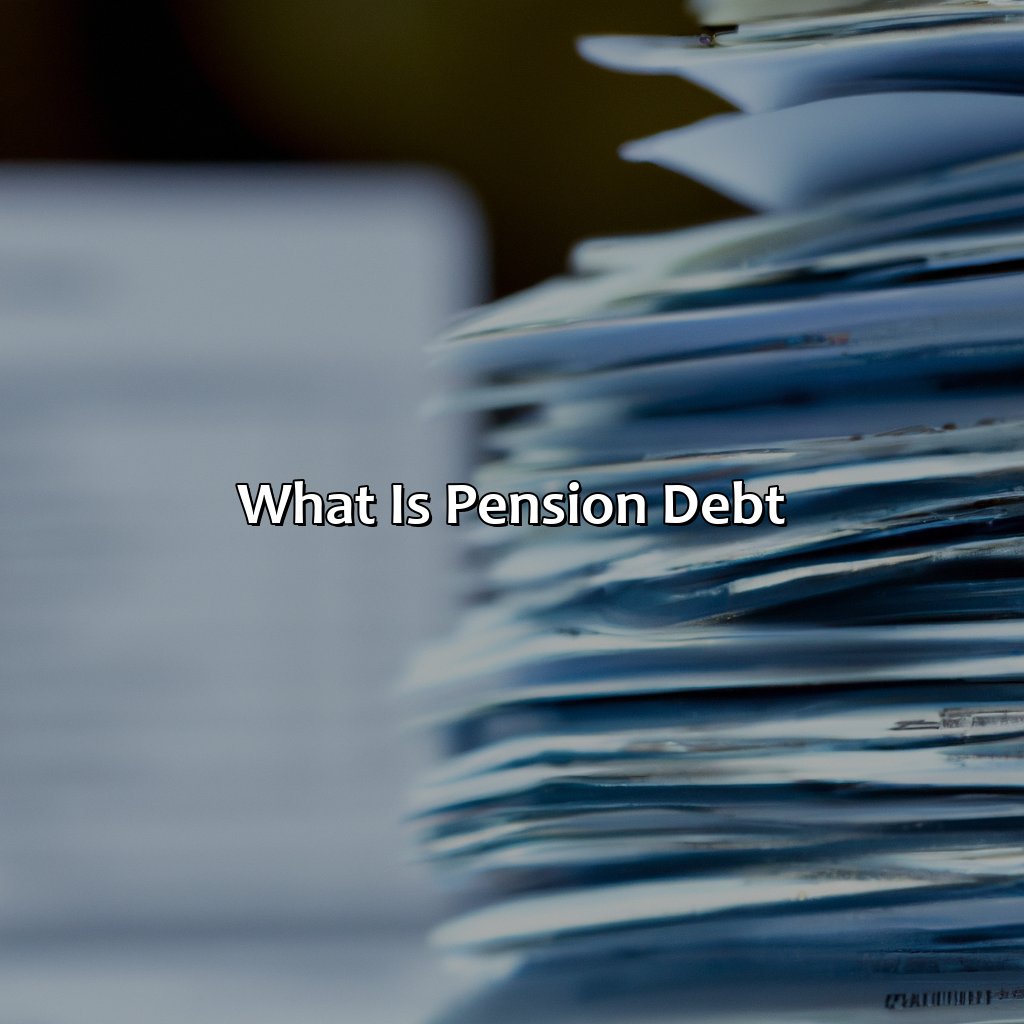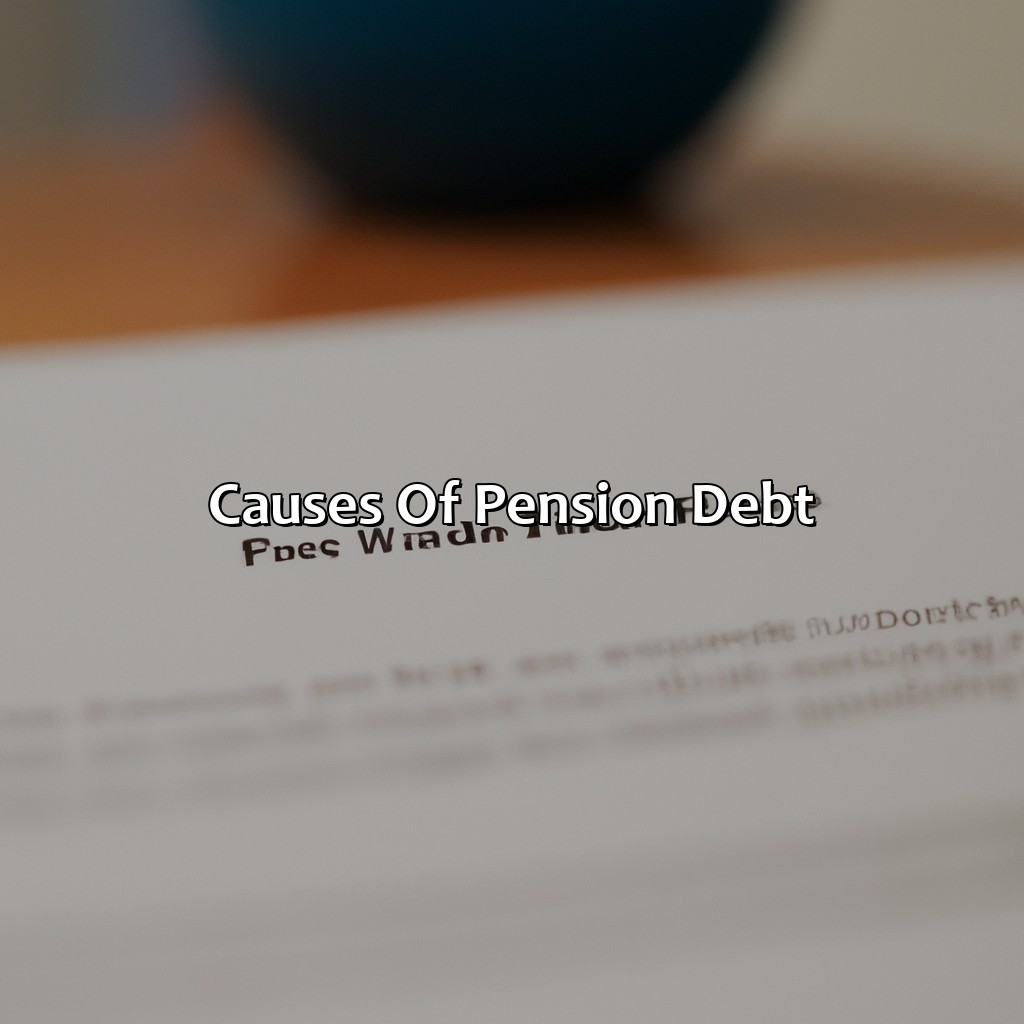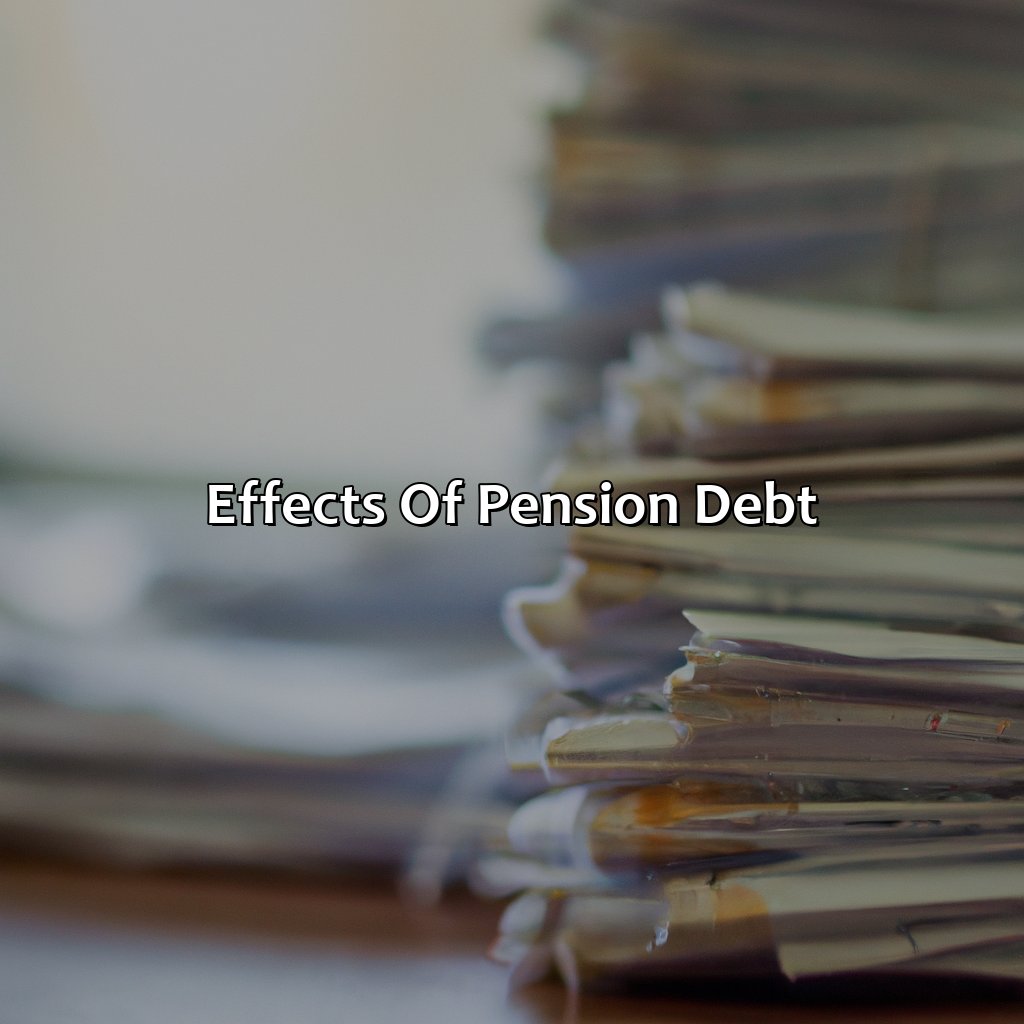What Is Pension Debt?
Key Takeaway:
- Pension debt is a result of poor funding policies and inadequate investment returns that lead to a shortfall in the amount of pension benefits owed to current and future retirees.
- There are different types of pension debt, including unfunded liabilities and underfunded plans, which vary in severity and impact on retirees and governments.
- Solutions to pension debt include reforming pension policies and implementing sound funding strategies, such as increasing contributions, reducing benefits, and diversifying investments.
Are you losing sleep over your financial future? Worried about pension debt? Keep reading to learn more about this increasingly important aspect of retirement planning. You deserve to understand how pension debt can affect your financial security.
What is Pension Debt?
What is Pension Debt? Let’s break it down.
Definition: Pension Debt is debt that affects individuals and society.
Explanation: It requires a clear definition and explanation.
Types: There are different types of Pension Debt. So let’s explore them to answer any doubts!

Image credits: retiregenz.com by James Washington
Definition and Explanation of Pension Debt
Pension debt is a type of financial obligation that occurs when a pension plan owes more to its beneficiaries than it has the ability to pay. This situation arises when pensions are underfunded, and contributions plus returns on investments are not sufficient to cover their liabilities. Pension debt can result in negative consequences for both employees and employers, including reduced benefits or increased employer contributions.
When a pension plan experiences pension debt, it can have serious implications for the long-term financial well-being of both the plan and its participants. In order to avoid or mitigate this risk, many plans engage in a process known as de-risking, which involves reducing investment risks and liability exposures through various means such as shifting investment focus towards bonds rather than stocks or purchasing annuity contracts.
While some approaches to addressing pension debt may be effective in the short term, there are concerns that they may lead to unintended consequences in the long term. For example, if a pension fund shifts too heavily towards investing in conservative investments like government bonds, they could see lower returns over time which would put additional pressure on employers to make up funding shortfalls.
Historically, public sector pension funds have been particularly prone to experiencing high levels of pension debt due to factors such as generous benefit formulas and expecting unrealistic rates of return from investment portfolios. In recent years, these issues have become increasingly common among private sector plans as well.
To understand more about this topic, you can read this guide on what is public pension.
Prepare for a crash landing into the world of pension debt types, where phrases like ‘unfunded liabilities’ and ‘underfunded plans’ are spoken with the seriousness of a heart attack.
Types of Pension Debt
Pension Obligations: Types and Varieties
Pension debt refers to the obligation of pension funds to provide a specified amount of retirement income to its members. Several types of pension debt exist, including:
- Unfunded Pension Liability – When a pension fund’s obligations exceed its assets.
- Underfunded Pension Plan – A plan with insufficient assets compared to its obligations.
- Normal Cost – The amount required for a pension fund to meet current and future benefits earned by employees.
- Accrued Liability – The present value of future benefits that retired or current employees have already earned.
It is crucial to understand the specifics of each type of pension obligation. For example, underfunded or unfunded pensions put pressure on government budgets and can lead to delayed payments or reduced public services. To ensure proper planning and management, it is essential always to evaluate the pension liabilities and make adjustments as required. Failure to do so could lead to crippling debt, leaving members without their expected contribution. Don’t let pension debt creep up on you – take action today and protect your financial future! Retirees are living longer and politicians are living in denial, leaving us with more pension debt than a Vegas high-roller on a losing streak.
Causes of Pension Debt
To fathom the source of pension debt, let us take a deeper glance. Poor policies and inadequate returns are the resolution. Parties didn’t keep up with the extra benefits and mismanaged investments. We explore two key variables that are responsible for the pension debt debacle.

Image credits: retiregenz.com by David Duncun
Poor Funding Policies
A primary reason behind pension debt is inadequate financial policies. Flaws in the funding approach of a pension plan result in unfunded liabilities that contribute to pension debts. This kind of pension liability happens when the amount required by the plan’s obligations surpasses the current assets and income streams.
Poor funding policies result from an insufficient understanding of how much money needs to be set aside for future payouts. Pension funds also face challenges due to inappropriate investments and volatile markets, often resulting in significant fluctuations in asset values, leaving them inadequately funded.
\nTo understand more about retirement savings, it’s important to know what pension scheme is and how it works.
Moreover, such flawed policies create uncertainty about an organization’s financial standing, limiting investors’ trust and possibly reducing its credit rating. The process can lead employees or members to withdraw their contributions, decreasing the fund’s value even more.
Reports across several countries suggest several examples of such issues with inadequate financing models that have resulted in sizable shortfalls for pension plans. For instance, Detroit reported millions of dollars in unfunded pensions leading up to its bankruptcy declaration.
The issue has pushed organizations and governments worldwide to rethink their respective approaches towards pensions through various regulations and funding strategies that could offer better stability to those who depend on these plans for retirement security. If you’re wondering where does pension money come from, it’s important to understand the funding strategies used by pensions.
Pensions may have a lot of baggage, but it turns out their investments are carrying the most weight.
Inadequate Investment Returns
Insufficient ROI on pension investments
Poor investment returns can lead to pension debt. Pension funds invest on stock markets, financial securities, and other sectors to generate revenue for their beneficiaries. However, if the return on investment (ROI) is insufficient or not as expected, it retains hardships for the businesses that contribute to pension funds. They need to contribute more money in order to pay pensions and other benefits. If you want to know more about pension benefits and the commuted value of pension, check out our website.
Inadequate returns can emerge from many sources such as sudden shifts of national economies, global recessions, low-interest rates on government bonds, insufficient diversification of assets or even incompetence by fund managers. Underperforming investments can also arise due to changes in corporate policies or poor planning by investment administrators.
One way pension funds can resist poor performance is by extending investing into diverse asset classes like equity stocks and corporate bonds. Expert consultants with skills in asset management strategies may help pension funds maximize revenue while minimizing the risks involved. Additionally, careful monitoring of financial data must be done regularly and appropriate adjustments made where necessary so that risks are evenly distributed among various portfolios.
Overall, obtaining high yields remains a primary concern of most benefit providers who utilize this approach while maintaining acceptable risk levels aimed at thwarting financial harm from ineffective portfolio management methodologies.
You can run from pension debt, but you can’t hide from the effects of it.
Effects of Pension Debt
To grasp the consequences of pension debt, dive into the financial and social effects.
Take a closer look at how it affects governments and pensioners. Do you know what a pay as you go pension plan is and how it works?
Also, investigate the far-reaching social effects beyond these parties.

Image credits: retiregenz.com by Joel Washington
Financial Consequences for Governments and Pensioners
The financial implications for both governments and pensioners as a result of pension debt can be staggering. Governments may face increased budget deficits, while pensioners may encounter reduced benefits or even loss of their retirement income.
| Financial Consequences | Governments | Pensioners |
|---|---|---|
| Increased budget deficits | Due to obligations to fund pensions | Reduced benefits or loss of income |
| Strained resources and services | Competition for limited funding | Difficulty making ends meet |
| Heightened taxes | To pay off debt and meet obligations | Reduced ability to afford necessities |
Pension debt can have other negative effects, including straining government resources and services meant for the public s benefit. The consequences outlined in the table demonstrate how this type of debt affects governments and individuals differently.
Governments facing high levels of pension debt might consider different strategies for lessening the burden. A few options include increasing contributions, reforming benefits, or lowering the discount rate used to determine future liabilities. Each strategy aims at reducing long-term liability by decreasing costs or increasing revenue through reasonable measures. If you’re curious about how a pension is paid out, check out this helpful guide.
Looks like retirement isn’t the only thing we’re leaving future generations…hello, pension debt, nice to meet you.
Social Consequences
The impact of pension debt goes beyond just economic repercussions. Societal implications arise from the inability to fund pensions, such as the strain on social services and government programs. The consequences can be devastating, particularly for vulnerable populations who rely heavily on pensions for their livelihood.
Moreover, pension debt can lead to a decrease in public trust in government institutions and increase political polarization. When people perceive that their retirement security is at risk and their tax dollars are being mismanaged, they may lose confidence in the government’s ability to address social issues. To understand how it works, you can learn about pension loans and their impact on retirement funds.
Additionally, pension debt can exacerbate income inequality. Workers who have reliable pensions are more likely to have stable incomes during retirement, while those without such plans face higher rates of poverty and financial insecurity. This increased stratification can also contribute to a wide range of social problems. Check out how a pension works in the UK for more information.
Understanding the broader social impacts of pension debt is crucial for policymakers looking to make informed decisions around funding and reforming public pensions.
In one case, a city’s underfunded pension system led to cuts in public safety budgets, resulting in reduced staffing levels and longer response times for emergency services. This illustrates the real human cost of pension liabilities and emphasizes the importance of addressing this issue proactively before it spirals out of control.
Who needs a solution to pension debt when you can just retire to a deserted island and start a new civilization with your fellow broke retirees?
Solutions to Pension Debt
Two main solutions for tackling pension debt and its vast financial effects can be adopted: revising pension policies and utilizing effective funding strategies. These subsections offer alternate paths to managing pension debt and maintaining pension systems’ sustainability.

Image credits: retiregenz.com by David Arnold
Reforming Pension Policies
Pension System Reforms are crucial to address ongoing pension debts. The significant changes must involve public policy reforms, increasing retirement age and pension contributions, and improved governance mechanisms. Policymakers need to consider revising funding policies, benefit formulas, and accounting standards. A comprehensive review would result in a more robust and sustainable system.
Furthermore, policymakers must address the inadequate governance structure that impedes smooth operations of pension funds. They should focus on making the administration process more transparent and efficient by introducing better technology and reporting systems while reducing the bureaucracy.
In addition, looking towards other countries’ practices can assist effective implementation strategies. Chile underwent fundamental reform in 1981 that helped establish mandatory savings requirements for workers rather than relying solely on employer contributions. Evidence suggested that this model reduced poverty rates among the older population substantially.
History has shown there were instances where pensions were removed entirely or significantly reduced due to shortfall-related issues in the United States of America in Dallas (2008) and Prichard (2009). It emphasizes why it is crucial for proper attention to be paid to this matter.
The reforms aimed at managing Pension Debt can keep significant benefits for both Pension Funds and general public economic stability when adequately communicated, understood and implemented globally.
Securing your pension plan is like securing your seatbelt – it’s better to have it and not need it than to need it and not have it.
Implementing Sound Funding Strategies
A crucial aspect of pension management is ensuring the availability of adequate funds to meet future liabilities. This necessitates the implementation of effective funding strategies that take into account market conditions, actuarial projections and other factors that can impact fund performance. Adopting sound funding strategies can help mitigate potential pension debt and ensure the longevity and stability of the pension plan.
Funding strategies must be designed in consideration of a range of market factors, including interest rate environments, inflation rates, and asset class performances, among others. Certain investment vehicles such as alternative investment funds (AIFs), hedge funds and exchange-traded funds (ETFs) may also be used to manage risk within portfolios.
The application of consistent monitoring protocols ensures the effectiveness of such strategies by creating reaction plans to adverse events. Monitor obligations being discharged early enable a slow reduction of costs over time with tolerance for underfunded pensions adjusted accordingly.
While many find solace in unrealistic pay-offs via risky investments, successful pension funding requires prudent planning and patience over solid economic footholds. A thorough understanding of all associated risks through effective communications creates informed expectations alongside a stable enduring future for beneficiaries’ returns on contributions paid in their working years.
Example Story: The state employee’s retirement board experienced public outcry when disclosures emerged. Certifying payouts up until death were inclusive in their offerings to employees who had retired before 2005 via selling Employee Retirement Income Security Act unfunded liabilities at $2 million each themselves soon killed off most benefactors. One employee became an overnight millionaire after only paying just over $1000 with seven-figure-a-year annuity cash flow until death was bought back by the government resulting in him losing his fortune and future stability for him and his family members who now rely solely on Medicaid.
Five Facts About Pension Debt:
- ✅ Pension debt refers to debt accrued by pension funds when they are unable to make promised payouts to beneficiaries. (Source: Investopedia)
- ✅ Pension debt is a growing concern in many developed nations due to an aging population and insufficient funding levels. (Source: World Economic Forum)
- ✅ The U.S. public pension system alone is facing an estimated $4.4 trillion in unfunded liabilities. (Source: Forbes)
- ✅ Pension debt can lead to cuts in pension benefits, higher taxes, and budgetary strain on local governments. (Source: The Balance)
- ✅ Solutions to address pension debt include increasing contributions, shifting to defined contribution plans, and reducing benefits for future retirees. (Source: National Conference of State Legislatures)
FAQs about What Is Pension Debt?
What is pension debt?
Pension debt refers to the amount of money that a government or organization owes to its current and retired employees in the form of pension benefits. This debt arises when the employer contributes less to the pension plan than necessary to cover the benefits promised to employees.
How does pension debt accumulate?
Pension debt accumulates when an employer with a defined benefit plan fails to contribute enough money to the plan to fund the promised benefits. This can happen if the employer either underestimates the amount needed to fund the plan or chooses not to contribute the necessary amount.
Why is pension debt a problem?
Pension debt can create significant financial problems for governments and organizations. If the employer fails to provide enough money to cover pension obligations, it may be required to make up the difference, which can lead to reduced services, layoffs, and higher taxes. Moreover, if the pension plan is underfunded, there may not be enough money to pay retirees the benefits they were promised.
What are the consequences of pension debt?
The consequences of pension debt can be severe for both pensioners and taxpayers. Unfunded pension obligations can strain state and local budgets, causing cutbacks in services like education, transportation, and public safety. Employees may also bear the brunt of the issue, as employers try to cut costs by reducing benefits or enacting layoffs.
Can pension debt be avoided?
Pension debt can be avoided if employers fund their pension plans adequately and responsibly. This requires employers to make contributions to the plan on a regular basis, based on actuarial calculations of expected future costs. It also requires employers to have a clear understanding of how much money will be needed to fulfill their pension obligations.
How is pension debt being addressed?
Several strategies are being employed to address pension debt in the public and private sectors, such as increasing employee contributions, reducing benefits, and reforming the pension plan structure. Governments and organizations are also exploring ways to better fund their pension plans and explore alternative retirement options for employees. With proper planning and management, pension debt can be prevented and controlled.
